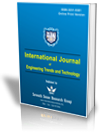Heat Flow Analysis in Corrugated Plate Heat Exchanger using MWCNT Nanofluid at Various Corrugated Angles, Volume Flow Rate, Phi
Heat Flow Analysis in Corrugated Plate Heat Exchanger using MWCNT Nanofluid at Various Corrugated Angles, Volume Flow Rate, Phi |
||
 |
 |
|
| © 2025 by IJETT Journal | ||
| Volume-73 Issue-11 |
||
| Year of Publication : 2025 | ||
| Author : K N V Sreedevi, Somanchi Naga Sarada | ||
| DOI : 10.14445/22315381/IJETT-V73I11P113 | ||
How to Cite?
K N V Sreedevi, Somanchi Naga Sarada,"Heat Flow Analysis in Corrugated Plate Heat Exchanger using MWCNT Nanofluid at Various Corrugated Angles, Volume Flow Rate, Phi.", International Journal of Engineering Trends and Technology, vol. 73, no. 11, pp.165-172, 2025. Crossref, https://doi.org/10.14445/22315381/IJETT-V73I11P113
Abstract
A comprehensive Study investigates thermal performance in a Corrugated Wavy plate heat exchanger utilizing Multi-Walled Carbon Nanotube (MWCNT)-based nanofluids, with a focus on the combined effects of flow-rate, nano-particle concentration, and corrugation angle on efficiency. Experiments were conducted across varying flow rates (2–4 LPM), MWCNT concentrations, phi (∅, 0,0.01,0.03,0.05,0.07,0.09%), and plate angles (0°–60°) to evaluate their individual and synergistic impacts on heat transfer. The results show that an increase in Volume Flow Rate(lpm) increases both heat transfer rate, Q(Watts), and pressure drop (Pascal). Elevating nanoparticle concentration to 0.09% leads to increased heat transfer rate and unwanted pressure drop. Inclination angle markedly influences performance, with optimal(maximal) heat-transfer-rate at 40 ° with optimal(minimal) pressure-drop at 0 ° inclination angle. Corrugated angle, lpm, nanoparticle concentration elevates Q at the cost of pressure drop. An attempt is made to find optimum parameters that enhance the heat transfer rate and reduce the pressure drop. With water as test fluid, maximum HTR is 2060.847W at 30o ° cphe’ angle, at 3lpm. For MWCNT nanofluid as test fluid, max HTR is 2431.613W at 50o ‘cphe ‘angle,4lpm. An 18% increase in HTR is observed. Minimum pressure drop is 7.328871pascal at 0o,2 lpm with water as test fluid, and 7.49995 pascal at 0.01% phi,2lpm at 0 ° corrugated angle with nanofluid as test fluid. Pressure drop almost remained constant for water and 0.01% nanofluid. Optimal response from designxpert software is found to be 7.5pascal pressure-drop,2431.6Watts HTR at 50 degrees, 4lpm,0.01% nanoparticle concentration with 0.7 overall desirability.
Keywords
Corrugated Wavy Plate Heat Exchanger, Corrugated Angle, HTR, Optimum, Phi, MWCNT.
References
[1] R. N. Hegde, S. S. Rao, and R. P. Reddy, “Studies on Nanoparticle Coating Due to Boiling Induced Precipitation and its Effect on Heat Transfer Enhancement on a Vertical Cylindrical Surface,” International Journal of Heat and Mass Transfer, vol. 38, pp. 229-236, 2012.
[CrossRef] [Google Scholar] [Publisher Link]
[2] Vikas Kumar, Arun Kumar Tiwari, and Subrata Kumar Ghosh, “Application of Nanofluids in Plate Heat Exchanger: A Review,” Energy Convers Manage, vol. 105, pp. 1017-1036, 2015.
[CrossRef] [Google Scholar] [Publisher Link]
[3] S. Suresh et al., “Effect of Al2O3-Cu/ Water Hybrid Nanofluid in Heat Transfer,” Experimental Thermal and Fluid Science, vol. 38, pp. 54-60, 2012.
[CrossRef] [Google Scholar] [Publisher Link]
[4] S. Suresh et al., Turbulent Heat Transfer and Pressure Drop Characteristics of Dilute Water based Al2O3–Cu Hybrid Nanofluids,” Journal of Nanoscience and Nanotechnology, vol. 14, no. 3, pp. 2563-2572, 2014.
[CrossRef] [Google Scholar] [Publisher Link]
[5] Atul Bhattad, Jahar Sarkar, and Pradyumna Ghosh, “Experimentation on Effect of Particle Ratio on Hydrothermal Performance of Plate Heat Exchanger using Hybrid Nanofluid,” Applied Thermal Engineering, vol. 162, 2019.
[CrossRef] [Google Scholar] [Publisher Link]
[6] Weiting Jiang, Guoliang Ding, and Hao Peng, “Measurement and Model on Thermal Conductivities of Carbon Nanotube Nano Refrigerants,” International Journal of Thermal Sciences, vol. 48, no. 6, pp. 1108-1115, 2009.
[CrossRef] [Google Scholar] [Publisher Link]
[7] A.E. Kabeel, T. Abou El Maaty, and Y. El Samadony, “The Effect of using Nano-Particles on Corrugated Plate Heat Exchanger Performance,” Applied Thermal Engineering, vol. 52, no. 1, pp. 221-229, 2013.
[CrossRef] [Google Scholar] [Publisher Link]
[8] S.M. Hashemi, and M.A. Akhavan-Behabadi, “An Empirical Study on Heat Transfer and Pressure Drop Characteristics of CuO-Base Oil Nanofluid Flow in a Horizontal Helically Coiled Tube under Constant Heat Flux,” International Communications in Heat and Mass Transfer, vol. 39, no, 1, pp. 144-151, 2012.
[CrossRef] [Google Scholar] [Publisher Link]
[9] M.A. Ahmed, N.H. Shuaib, and M.Z. Yusoff, “Numerical Investigations on the Heat Transfer Enhancement in a Wavy Channel using Nanofluid,” International Communications in Heat and Mass Transfer, vol. 55, no. 21-22, pp. 5891-5898, 2012.
[CrossRef] [Google Scholar] [Publisher Link]
[10] A.K. Tiwari, P. Ghosh, and J. Sarkar, “Heat Transfer and Pressure Drop Characteristics of CeO2/Water Nanofluid in Plate Heat Exchanger,” Applied Thermal Engineering, vol. 57, no. 1-2, pp. 24-32, 2013.
[CrossRef] [Google Scholar] [Publisher Link]
[11] Naghmeh Jamshidi et al., “Optimization of Design Parameters for Nanofluids Flowing Inside Helical Coils,” International Communications in Heat and Mass Transfer, vol. 39, no. 2, pp. 311-317, 2012.
[CrossRef] [Google Scholar] [Publisher Link]
[12] M.N. Pantzali, A.A. Mouza, and S.V. Paras, “Investigating the Efficacy of Nanofluids as Coolants in Plate Heat Exchangers (PHE),” Chemical Engineering Science, vol. 64, no. 14, pp. 3290-3300, 2009.
[CrossRef] [Google Scholar] [Publisher Link]
[13] Amirhossein Zamzamian et al., “Experimental Investigation of Forced Convective Heat Transfer Coefficient in Nanofluids of Al2O3/EG and CuO/EG in a Double Pipe and Plate Heat Exchangers Under Turbulent Flow,” Experimental Thermal and Fluid Science, vol, 35, no. 3, pp. 495-502, 2011.
[CrossRef] [Google Scholar] [Publisher Link]
[14] Y.H. Kwon et al., “Heat Transfer and Pressure Drop Characteristics of Nanofluids in a Plate Heat Exchanger,” Journal of Nanoscience and Nanotechnology, vol. 11, no. 7, pp. 5769-5774, 2011.
[CrossRef] [Google Scholar] [Publisher Link]

